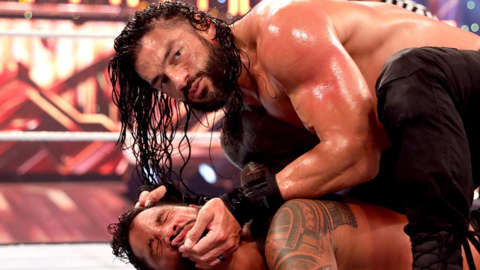The Big Dog is dead. The Tribal Chief has risen.
In the main event at WWE Clash of Champions, cousins Jey Uso and Roman Reigns have a moment similar to one in Martin Scorsese’s Casino–where Tommy begs for his brother’s life when the two are being beaten to death with baseball bats. At the end of the PPV match, Reigns is administering a beating that, if it were to happen in real life, would qualify as attempted murder. And finally, Jey’s brother Jimmy limps out from the locker room to throw in the towel and save his brother from permanent damage. Jimmy cradles Jey’s limp body, guarding his brother as he yells at Roman.
“We’re family!” Jimmy yells, his voice cracking with emotion. “What the hell is wrong with you? You’re the Chief. You’re the Tribal Chief. Just leave him alone!”
It was a heart-wrenching moment, primarily because the story of the Usos and Roman Reigns is really the story of the Samoan Anoa’i family, which has played a dominant part in WWE’s storylines for four decades. It began with family patriarchs Afa and Sika, who joined the WWE in 1979 as the Wild Samoans. And it’s continued through four generations of WWE Superstars, including Yokozuna, The Rock, Umaga, The Headshrinkers (Rikishi/Fatu and Samu), and Rosey. Everything involving this family is loaded with that added context–a reputation for toughness, determination, and familial solidarity.
So, in terms of kayfabe, Roman’s repeated demands to be called “Tribal Chief” signifies something greater than the Universal Championship; he is fully embodying the lineage that birthed him. But, in true heel fashion, he’s also asserting himself as superior to it, which frees him from its pressures even as he embraces them.
Roman Reigns has been rejuvenated by this abrupt change in attitude–of putting himself rather than his extended family first. It starts with his look. He’s no longer wearing his signature Shield vest; he’s bare-chested, which gives us a good look at his tribal tattoos and immense physicality. The man, quite frankly, is built like a god. Why did WWE ever hide his muscles in the first place?
He walks to the ring with a slow, deliberate gait, like a man who knows that the audience can wait because he’s the one that everyone is paying to see. And manager Paul Heyman, who is walking alongside him, has a look on his face that’s a cross between stoic and terrified. This is the same man who strutted to the ring alongside Brock Lesnar with a smirk on his face. The implication is clear: if Heyman is afraid of what this guy might do, then we should be frightened too.
Roman, no longer limited by WWE’s definition of what a “good guy” babyface ought to be, takes his time as the match begins. He doesn’t go for the crowd-pleasing power moves–a Superman Punch, followed by additional Superman punches. Instead, he locks up and grapples. And he proves what many wrestling observers knew for years, but many of his detractors seemed to deny: he can work and lead a match very, very well.
It’s a classic heel technique to take things slowly. It makes the audience anxious for what’s to come. Done properly by a dominant heel, it gives every punch and kick a weighty impact. It feels cruel and sadistic, as though the beating is being dragged out far longer than it has to. Brock Lesnar does this a lot; he spends large portions of the match waiting for his opponent to stand, only to maul and suplex him to the mat for the tenth time. Roman taunts his cousin, telling him to stay down and take the main event payday instead of continuing to fight.
Of course, Jey doesn’t listen. He also plays his role perfectly, as an underdog who gets in a flurry of high-flying, visually impressive offense, only to be cut down by a single, brutal right hand. By the end of the match, he’s moaning like a dying man, and still snaps hard for every Spear that Roman throws at him. And by never conceding (his brother has to save him), he maintains his dignity in defeat.
The ending was not cathartic, with a perfectly framed shot to neatly wrap things up. It was awkward and weirdly shot, like we were seeing something intimate and personal–family business that should have been addressed outside of the ring. WWE does very well when it engages in worked shoot premises–scripted storylines with real-life elements added in. And Roman Reigns, given the opportunity to address his past and chart his future, did so perfectly, within the confines of a professional wrestling match.
What could be on the horizon for the Tribal Chief? How about a showdown with his cousin The Rock at next year’s Wrestlemania? We just might have to wait that long to see a worthy challenger to Reign’s reign. But then again, the WWE fans waited a long time–too long, by my estimate–to see this mean, sadistic side of Roman Reigns. Now that it’s finally here, I can’t wait to see more.
Disclosure: ViacomCBS is GameSpot’s parent company
By Kevin Wong

